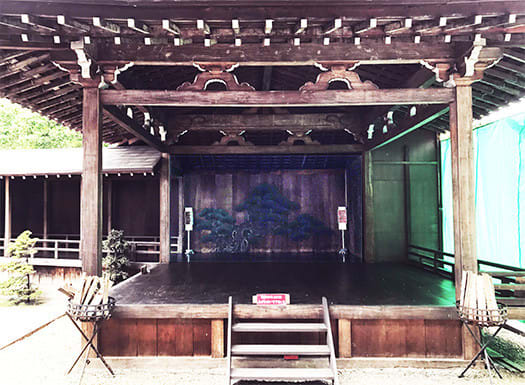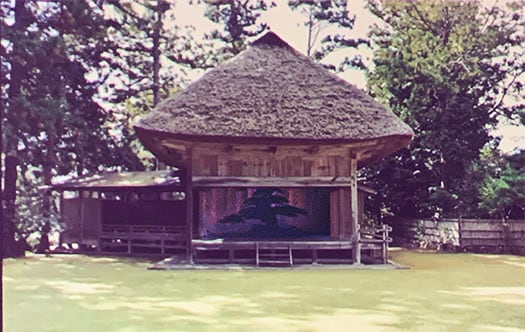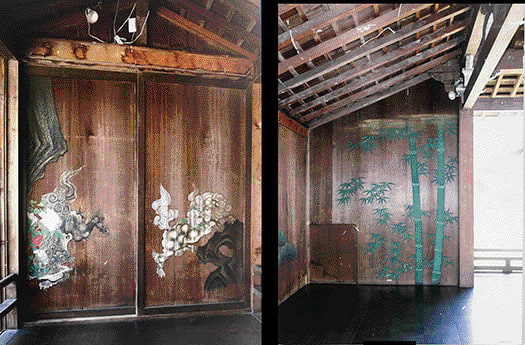


佐渡出身の小樽の実業家一族・岡崎家の2代当主、謙氏造営の能舞台。
2枚目の写真はかれが10才まで過ごしていた郷里・佐渡の能舞台。
1843年創建と伝わる「大膳神社能舞台」です。
江戸時代末期ということになるけれど、
田舎の神社境内にこういう装置がしつらえられて地域の祭礼などで
能が興行され続けてきただろうことが偲ばれる。
たぶん北前船交易のネットワークに属する佐渡地域で
北海道小樽の開拓期のビジネスの活況に身を投じて
物流を司る仕事で「一旗あげた」父親。地元祭礼の時期には
北前船で帰省して、その膝に乗せられながら華やかで荘重な能や
楽しい狂言の舞台を感受性豊かな少年期に謙氏は体験したに違いない。
日本文化の粋が佐渡という里でも体験されたことで
強烈なその文化の存在感がかれの内面に育ったに違いない。
自然豊かな環境の中で、年に数度あるかないかの「非日常性」劇的空間性は
少年にある「生き甲斐」をもたらしたのだろう。
今日のわたしたちが接するテレビや映画とは比較を越えるものを感じる。
「今度の祭りで・・・」という人々の会話から少年たちは
その日本文化の特別感に触れ続け、そしてそれが能舞台での上演で
体験的クライマックスを迎えることになる。
刷り込まれる伝承的文化へのリスペクトは想像を超える。
青年期にはその体験が内面的に昇華されて能を習うことになる。
やがて父の逝去にともなって小樽での事業活動に没頭し、
そして社会的な役割を果たすなかから自分の内側から盛り上がるものがあって
能舞台の創造を念願するようになる。この生き様は理解できる。
用材にこだわり、信頼する佐渡の大工職人と協力して
小樽の地に能舞台を創建する活動をいわば「ライフワーク」とした。
総合芸術の仕上げとして狩野派の日本絵画まで一流にこだわった。
現代個人主義の時代を生きるわれわれの生き様とも通底するものがある。
岡崎謙氏が創造して残した能舞台から残照してくるものは大きい。
しかし後世のわたしたち社会ではこうした価値感が変容してしまった。
まずは年に数回の「ハレ」の時空間を存続させる地域ムラ社会が消滅した。
地域の祭りはその求心力が低下し続けている。
テレビや映画、そしてYoutube動画など、表現領域は無限大に拡大し
その受容体験はほぼまったく「日常化」する時代になった。
田舎の能舞台、という素朴な伝統文化性は大きく毀損している。
今日の社会の中で、こういう建築に残された日本文化を
どのように受け継いでいくのか、という課題テーマは大きくなっている。
駒木先生は小樽という地域のコアな文化としてこの能舞台建築を
存続させる活動に取り組まれているものと思う。
建築技術としてすら存続が困難になっていることも事実。
今日の文化社会は非常にきわどい局面を迎えていると強く思われます。
English version⬇
Inheritance of Noh Culture and Modern Society: Otaru's "Noh Stage" - 3
Noh, the cultural norm up to the prewar period, was certainly transplanted to Hokkaido, but it is difficult to carry it on in the modern age. Can Youtube carry on Noh? Noh, however, is difficult to inherit in the modern age.
The Noh stage built by Ken Okazaki, the second head of the Okazaki family, an Otaru business family from Sado Island.
The second photo shows the Noh stage in his hometown of Sado, where he lived until the age of 10.
It is the "Ozen Shrine Noh Stage," which is said to have been built in 1843.
It was built at the end of the Edo period.
This kind of stage was set up in the precincts of a shrine in the countryside, and Noh plays have been performed
It is reminiscent of how Noh plays were performed at local festivals and other occasions.
The Sado region probably belonged to the Kitamae Ship trading network.
In the Sado region, which probably belongs to the Kitamaebune trading network, he threw himself into the booming business of the pioneering period in Otaru, Hokkaido.
father who "made it big" in the logistics business. During the local festival season
on the Kitamae-bune, and he would take his father on his lap to see the gorgeous and solemn Noh plays and the
He must have experienced the glamorous and solemn Noh plays and joyful Kyogen performances as a sensitive young boy.
The fact that the best of Japanese culture was experienced in the village of Sado
The strong presence of this culture must have grown inside him.
In an environment rich in nature, the "unusualness" and dramatic space, which may or may not occur more than a few times a year, brought a "purpose in life" to the boy.
The dramatic space of the "extraordinary" in a rich natural environment, which occurs only a few times a year, must have given the boy a certain "joie de vivre".
I feel that there is something beyond comparison with the TV programs and movies that we are exposed to today.
The boys continued to experience the specialness of Japanese culture through the conversation of people who said, "At the next festival...
The boys continued to experience the specialness of Japanese culture through conversations about the upcoming festival, which culminated in the experience of the Noh stage performance.
The experiential climax of the performance on the Noh stage.
The respect for the traditional culture that is imprinted on them is beyond imagination.
In his youth, this experience was sublimated internally and he began to learn Noh.
After his father's death, he immersed himself in business activities in Otaru, and as he took on a social role, he began to learn Noh.
And as he fulfilled his role in society, he felt something rising up from within himself.
He began to desire the creation of a Noh stage. This way of life is understandable.
He was particular about the materials he used and cooperated with carpenters in Sado Island, whom he trusted.
He made it his "life's work," so to speak, to build a Noh stage in Otaru.
As the finishing touch to his comprehensive art, he was particular about first-rate Japanese paintings of the Kano school.
His life's work has something in common with the way we live in today's age of individualism.
The Noh stage created and left behind by Mr. Ken Okazaki is a great source of inspiration.
However, in our society of later generations, this sense of value has been transformed.
First of all, the local mura (village) society that sustained the "hare" (a time and space for festivals) that took place only a few times a year has disappeared.
Local festivals continue to lose their centripetal force.
The realm of expression has expanded to infinity through TV, movies, and Youtube videos.
The experience of receiving these expressions has become almost completely "everyday.
The simple traditional culture of the Noh stage in the countryside has been severely damaged.
In today's society, how can we pass on the Japanese culture
How do we pass on the Japanese culture left behind in these architectural structures?
Dr. Komaki is involved in activities to keep the Noh stage architecture alive as the core culture of the Otaru area.
I believe that Dr. Komaki is involved in activities to keep the Noh stage architecture alive as the core culture of the Otaru region.
It is a fact that it is becoming difficult to sustain even as an architectural technology.
I strongly believe that today's cultural society is at a critical juncture.










